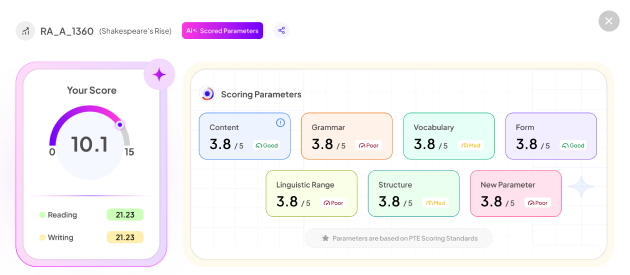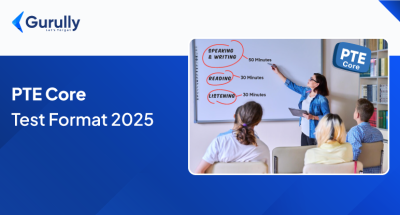The Pearson Test of English (PTE) exam is widely recognized for its emphasis on testing English proficiency for those planning to study or work abroad. One of the key sections that often challenges test-takers is the PTE Speaking section. This section evaluates your ability to speak English fluently and your comprehension and memory skills. Among the various tasks in this section, the PTE Repeat Sentence task is one of the trickiest. To crack this question, here are PTE repeat sentence tips and templates along with sample question and answer.
What Is PTE Repeat Sentence Task
The PTE Repeat Sentence task requires you to listen to a short sentence (usually around 3 to 9 seconds long) and repeat it as accurately as possible. The sentences are spoken only once, and you don’t have the option to replay them. You’ll need to start speaking immediately as soon as the sentence is completed.
| PTE Academic | ||
| Prompt Length | Skills Assessed | Time to Answer |
| 3-9 Seconds | Listening & Speaking | 15 Seconds |
| PTE Core | ||
| Prompt Length | Skills Assessed | Time to Answer |
| 3-9 Seconds | Listening & Speaking | 40 Seconds |
Why PTE Repeat Sentence Is an Important Question Type:
This task tests your ability to listen, understand, and recall information quickly while also maintaining fluency and pronunciation. In this question type, the weightage of scores will affect both speaking & listening. The score contribution of Repeat Sentence is quite high compared to other questions, so prepare for it carefully.
Scoring Format of PTE Repeat Sentence:
Scoring of Repeat Sentence is based on three factors: Content, Oral Fluency, and Pronunciation
Content :
| For content factors, you will be given points on the following basis: | |
| 3 | You repeated all the words from the sentence in the correct order. |
| 2 | You repeated at least half of the words in the correct order. |
| 1 | You repeated less than half of the words in the correct order. |
| 0 | You barely repeated anything from the sentence. |
🗒️Note: Only replacements, omissions, and insertions are considered errors & will negatively affect your score. Hesitations, filled or unfilled pauses, and leading or trailing material do not affect the content scoring, however, it will impact your oral fluency scores.
Fluency:
| For fluency factors, you will be given points on the following basis of PTE Repeat Sentence: | ||
|
Oral Fluency
|
Native Like | 5 |
| Advanced | 4 | |
| Good | 3 | |
| Intermediate | 2 | |
| Limited | 1 | |
| Disfluent | 0 | |
Easy Breakdown Of Oral Fluency Factors of PTE Repeat Sentence:
Native-like (5 Points):
- Speech is smooth and natural.
- No hesitations, pauses, or restarts.
- No mistakes in pronunciation that sound non-native.
Advanced (4 Points):
- Speech flows well with good rhythm.
- Only one hesitation, repetition, or restart.
- Pronunciation is clear without noticeable mistakes.
Good (3 Points):
- Speech speed is fine but might not always be smooth.
- There could be more than one hesitation, but most of the time, you speak in phrases.
- Minimal repetitions or restarts.
- No long pauses.
Intermediate (2 Points):
- Speech may be uneven or choppy.
- There should be at least one smooth three-word phrase.
- No more than two or three hesitations, repetitions, or restarts.
- One long pause is allowed, but not more than that.
Limited (1 Points):
- Speech is irregular, with poor rhythm.
- Many hesitations, restarts, or repetitions.
- One or two long pauses may happen during longer speech.
Disfluent (0 Points):
- Speech is slow, with lots of pauses, hesitations, or restarts.
- Words are mostly isolated, not grouped into phrases.
- There are multiple long pauses and pronunciation errors.
Pronunciation:
| For pronunciation factors, you will be given points on the following basis PTE Repeat Sentence : | ||
|
Pronunciation |
Native Like | 5 |
| Advanced | 4 | |
| Good | 3 | |
| Intermediate | 2 | |
| Intrusive | 1 | |
| Non-English | 0 | |
Easy Breakdown Of Pronunciation Factors:
Native-like (5 Points):
- You sound almost like a native speaker. All vowels and consonants are clear and easy to understand.
- You use natural speech patterns and stress words perfectly.
- It’s hard to tell you’re a non-native speaker because your pronunciation is spot-on.
Advanced (4 Points):
- Your vowels and consonants are mostly clear.
- You might have small mistakes, but nothing that confuses listeners.
- Words are still easy to understand, and you stress the most important ones correctly.
Good (3 Points):
- You pronounce most sounds well, but some mistakes might make a few words unclear.
- A few sounds are regularly mispronounced or skipped, and you might not stress certain words as clearly as needed.
Intermediate (2 Points):
- Some of your consonants and vowels are often mispronounced, giving you a noticeable accent.
- Listeners can understand about two-thirds of what you say, but they may have to adjust to your accent.
- You may miss or simplify certain sounds; sometimes, your word stress is unclear.
Intrusive (1 Point):
- Many sounds are mispronounced, and you have a strong foreign accent.
- Listeners may only understand about one-third of what you say, and some sounds don’t follow English rules.
- Word stress is often wrong; you may skip sounds or add extra ones.
Non-English (0 Points):
- Your speech sounds more like another language than English.
- Many sounds are out of order, missing, or incorrect, and more than half of your speech is hard to understand.
- The stress and syllables in your words don’t match English at all.
Start your free PTE mock test with Gurully and get AI-powered analysis for a personalized journey.


- Kickstart your PTE prep with a free AI-scored mock test
- Boost your score with in-depth analysis & smart recommendations
Common Challenges in Repeat Sentence Task:
The PTE Repeat Sentence task in the Speaking section might seem straightforward, but it comes with several challenges that can hinder even well-prepared test-takers. Let’s explore the common difficulties encountered during this task:
- Memory Retention: It’s tough to remember the full sentence after hearing it only once. Under test pressure, it’s easy to forget parts of the sentence, leading to incomplete responses.
- Accent & Pronunciation: Understanding different English accents (American, British, and Australian) can be tricky, especially if you’re not used to them. Mispronunciation can lower your score.
- Fluency & Speed: Speaking too slowly or rushing can hurt your fluency. Finding the right balance between speed and clarity is challenging.
- Incorrect Repetition: Many students mix up words or paraphrase instead of repeating the sentence exactly, which reduces the content score.
- Nervousness: Exam stress can cause hesitation, stuttering, or rushing through the response, affecting overall performance.
Effective PTE Repeat Sentence Tips & Strategies for Success
Here are some PTE Repeat Sentence tips & strategies to enhance your performance in the PTE Repeat Sentence task, along with practical tips to implement them effectively:
💡 Develop Active Listening Skills
Active listening is essential for accurately repeating sentences. Here are some easy-to-apply tips:
- Concentrate Fully: Eliminate distractions by finding a quiet study space and using headphones when practicing with audio.
- Take Notes: Jot down keywords or phrases while listening. This helps you recall the structure of the sentence better.
- Summarize Audio Clips: After listening to a sentence, summarize it in your own words to reinforce understanding.
💡Practice Memory Techniques
Memory techniques can significantly improve your recall abilities. Here are simple methods to try:
- Create Associations: Link words in the sentence to personal experiences or stories. This makes them easier to remember.
- Visual Flashcards: To enhance memory retention, create flashcards with sentences on one side and their meanings or images on the other.
💡 Practice Repeat Sentence PTE on Mock Test
Practicing under real exam conditions can help reduce anxiety on the actual test day. Here’s how to simulate the exam experience:
- Mock Tests: Take full-length mock tests of Gurully to familiarize yourself with the exam format and pacing.
- Do Question-wise Practice: Do question-wise practice as it will help you understand where you are lacking.
💡Enhance Pronunciation and Fluency
Your pronunciation and fluency are critical to succeeding in the Repeat Sentence task. Here are tips to improve them:
- Speak Aloud Daily: Dedicate a few minutes each day to reading out loud. This practice helps improve pronunciation and builds fluency.
- Use Speech Apps: Utilize language learning apps that provide instant feedback on pronunciation.
- Tongue Twisters: Practice tongue twisters to improve your dictation and speed of speech. This can help with fluency and articulation.
💡Develop a Routine
Creating a consistent study routine can help you stay organized and focused. Here are tips for effective planning:
- Time Blocking: Set specific times during the week for PTE practice, ensuring you cover all exam sections.
- Mix Skills: Allocate time for each skill (listening, speaking, reading, and writing) to develop a well-rounded proficiency.
- Set Reminders: Use a planner or digital calendar to remind yourself of study sessions and practice tests.
💡 Record and Analyse Your Speaking
Recording yourself can provide valuable insights into your performance. Here’s how to do it effectively:
- Use Simple Tools: Utilize your smartphone or a voice recording app to capture your practice sessions.
- Playback and Review: Listen to your recordings to identify areas for improvement, such as mispronunciations or hesitations.
💡Stay Engaged with the Language
Engaging with the English language outside of formal study can reinforce your skills. Here are some fun and easy ways to do this:
- Watch Movies and Shows: Choose English-language films or series, and try to repeat sentences or phrases spoken by the characters.
- Listen to Music: Follow along with the lyrics of English songs, repeating the lines to practice your pronunciation and rhythm.
PTE Repeat Sentence Template For Academic & Core:
Sentence Starts:
If the sentence begins with a subject like “He,” “She,” “They,” or a place like “The school” or “The company,” be ready to use that as your start.
- Example: “The company decided to increase the prices.”
Middle Part:
Focus on the verb and key action.
- Example: “decided to increase the prices” – this part conveys the main action.
Sentence Ends:
Make sure to capture the ending phrase or object. Avoid trailing off.
- Example: “increase the prices” – maintain fluency till the last word.
PTE Repeat Sentence Example Question & Answers For Practice:
Audio:
Transcript: A study skill seminar is on for the students who require assistance
Audio:
Transcript: The knife and fork should be placed next to the spoon at the edge of the table.
Audio:
Transcript: The modern approach to the problem is to stress the symbolic side of human nature.
Audio:
Transcript: Please have copies of your seminar papers in the library a week in advance.
For effective practice, try Gurully’s online platform, which offers question-specific exercises to help you improve your repeat sentence skills. You can also take section-wise tests to identify areas needing improvement. Gurully’s PTE practice platform features full-length mock tests with AI scoring, giving you expert-designed practice and real-time exam simulation to boost your score and achieve your goals.
Conclusion:
Mastering the PTE Repeat Sentence task requires a combination of sharp listening, memory retention, and clear pronunciation. With its significant impact on listening and speaking scores, actively practicing, developing memory techniques, and enhancing fluency and pronunciation are crucial.
Utilizing PTE mock tests, consistent practice routines, and engaging with the language in fun ways, like watching movies or listening to music, can help improve your performance. By focusing on these PTE Repeat Sentence Tips, you can confidently tackle the challenges and boost your overall PTE score.
FAQ:
How can I improve my Repeat Sentence in PTE?
How to get 90-90 in PTE?
How to get 79+ in PTE writing?
How to get 100% on an essay?
Is 2 weeks enough for PTE?
Also Read:
- PTE Speaking Format – Preparation Tips & Tricks To Score Maximum
- Introduction In PTE – Things You Need To Know For Making A Strong Impression
Boost Your PTE Score with These Free Practice Tests:






